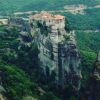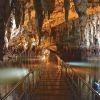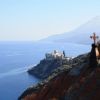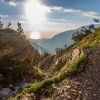Blog

27 ΜΑΡΤΙΟΥ 2019
A chance to visit the breathtaking monasteries of Meteora
0 comments
0 share
The view of the towering dark rocks is awe-inspiring. Nestled on their peaks and caves since the 11th century, the monasteries. With ropes, nets or bare hands the monks established a tradition of centuries: climbing. Today climbers from all over the world are coming to Meteora to confront them with the giant rocks. UNESCO has designated Meteora as a "Preserved and Protected Monument of Humanity". The Greek state is "a place sacred, unchangeable and inviolable". Add yourself your own rating to Meteora's Guestbook, which reaches 2 million each year.
It is worth seeing in Meteora
The "brutal" rocks of humble ascetics
In Thessaly, the complex of imposing rocks rises above Kalambaka, between Pindos and Antichasia. Monasticism began here in the 11th century, when monks of the ascetics left Mount Athos and came to Thessaly to practice in the caves of the vast rocks. In the 14th century Saint Athanasios Meteoritis organized the first communal community, establishing the monastery of the Great Meteora. Monks followed from other regions of Greece, setting up 20 monasteries in total.
Live "suspended" monasteries
Nowadays, there are six lively, refined and renovated monasteries, which welcome the pilgrim to their archangel. It is Agios Nikolaos Anapaşa, Metamorphosis of the Savior or Grand Meteora, Varlaam, Roussan, Holy Trinity and St. Stephen. The rest are either renovated, but without monks, or dilapidated.
Place for climbers
Climbing in Meteora never stopped. The monks and ascetics stood in the monasteries and their skeletons with ropes, nets or bare hands. Climbing on the rocks of Meteora continues today. It is a dream of life for many sports enthusiasts coming from every corner of the earth. Athletes enjoy classical climbing routes, that is, lengthy and unnecessary fuses. All are traditionally drawn from bottom to top. In the eyes of the unconscious, they seem impossible, as many of them stand almost vertically at a height of half a kilometer.
Kastraki: beautiful nest on the rocks
It nestles between the rocks and is the most beautiful village in the area and the base of climbers. It has restaurants, small hotels and rooms to rent, as well as tourist shops. Old Kastraki is a traditional settlement.
Kalambaka: the 'climb' gate
The city-gateway to Meteora. The commercial and tourist center of the area: here you will find many hotels, rooms to let and taverns that will make your holidays dream. Take a stroll to the old town (Stratos), which has been restored. Visit the unique School of Wood Sculpture in Greece as well as traditional bronze sculptures, where you can find rarely handcrafted bronze items.
The hidden treasures of Meteora
The cross-bridge of Sarakina
About 8 km from Kalampaka, towards Trikala, you will find the historical community of Sarakina. There is the largest stone bridge of the prefecture of Trikala, the famous Sarakina sixth bridge, which dates back to the 16th century. One of the area's most interesting sights.
The cave of Theopetra
Just 4 km outside of Kalambaka, you will find an evocative scenery, a cave-attraction that will spark your interest. Inside the cave, a main hall of 500 sq.m. about. The formation of the calcareous rock of Theopetra is placed in the upper Cretaceous period (137,000,000-65,000,000 years from today).
Hiking and mountain bike in Meteora
In Meteora, walking is particularly enjoyable and landscapes fascinate. You can do it organized with the help of alternative tourism companies operating in the area. Another option is the mountain bike.
We departure from Thessaloniki early in the morning to Meteora. The distance is 230km and lasts approximately 3 hours. During our way, there is a 30’ stop for rest and coffee.
We reach Meteora around 12:30 and we visit two of the six in operation Holy Monasteries depending on the operating schedule of each Monastery.
We make a stop to admire the panoramic view of the Holy Monasteries from up high.
Next, we enjoy Greek traditional lunch near Kalampaka in Kastraki in front of the view of the astonishing Meteora.
We depart to Thessaloniki at around 15:30 where in our way back we make a last stop for coffee and rest. We are back at about 19:00 making the same stops as when we started.
Price: 20 € per person
Bookings and enquiries:
Email: [email protected]
Phone: +30 2310 55 55 56
It is worth seeing in Meteora
The "brutal" rocks of humble ascetics
In Thessaly, the complex of imposing rocks rises above Kalambaka, between Pindos and Antichasia. Monasticism began here in the 11th century, when monks of the ascetics left Mount Athos and came to Thessaly to practice in the caves of the vast rocks. In the 14th century Saint Athanasios Meteoritis organized the first communal community, establishing the monastery of the Great Meteora. Monks followed from other regions of Greece, setting up 20 monasteries in total.
Live "suspended" monasteries
Nowadays, there are six lively, refined and renovated monasteries, which welcome the pilgrim to their archangel. It is Agios Nikolaos Anapaşa, Metamorphosis of the Savior or Grand Meteora, Varlaam, Roussan, Holy Trinity and St. Stephen. The rest are either renovated, but without monks, or dilapidated.
Place for climbers
Climbing in Meteora never stopped. The monks and ascetics stood in the monasteries and their skeletons with ropes, nets or bare hands. Climbing on the rocks of Meteora continues today. It is a dream of life for many sports enthusiasts coming from every corner of the earth. Athletes enjoy classical climbing routes, that is, lengthy and unnecessary fuses. All are traditionally drawn from bottom to top. In the eyes of the unconscious, they seem impossible, as many of them stand almost vertically at a height of half a kilometer.
Kastraki: beautiful nest on the rocks
It nestles between the rocks and is the most beautiful village in the area and the base of climbers. It has restaurants, small hotels and rooms to rent, as well as tourist shops. Old Kastraki is a traditional settlement.
Kalambaka: the 'climb' gate
The city-gateway to Meteora. The commercial and tourist center of the area: here you will find many hotels, rooms to let and taverns that will make your holidays dream. Take a stroll to the old town (Stratos), which has been restored. Visit the unique School of Wood Sculpture in Greece as well as traditional bronze sculptures, where you can find rarely handcrafted bronze items.
The hidden treasures of Meteora
The cross-bridge of Sarakina
About 8 km from Kalampaka, towards Trikala, you will find the historical community of Sarakina. There is the largest stone bridge of the prefecture of Trikala, the famous Sarakina sixth bridge, which dates back to the 16th century. One of the area's most interesting sights.
The cave of Theopetra
Just 4 km outside of Kalambaka, you will find an evocative scenery, a cave-attraction that will spark your interest. Inside the cave, a main hall of 500 sq.m. about. The formation of the calcareous rock of Theopetra is placed in the upper Cretaceous period (137,000,000-65,000,000 years from today).
Hiking and mountain bike in Meteora
In Meteora, walking is particularly enjoyable and landscapes fascinate. You can do it organized with the help of alternative tourism companies operating in the area. Another option is the mountain bike.
We departure from Thessaloniki early in the morning to Meteora. The distance is 230km and lasts approximately 3 hours. During our way, there is a 30’ stop for rest and coffee.
We reach Meteora around 12:30 and we visit two of the six in operation Holy Monasteries depending on the operating schedule of each Monastery.
- the women’s monastery of Agios Stefanos with the impressive wood-carved iconostasis and the magnificent view of the city of Kalampaka, the river Lithaios and the plain,
- the monastery of the Holy Trinity at the steepest rock of Meteora, through stairs cut through the stone,
- the women’s monastery of Rousanou with the extraordinary wall paintings of the small church, and the verdant path leading to it,
- the Varlaam monastery with the valuable surviving frescoes of the painter of icons Frangos Katelanos and, among others, the thirteen-ton wooden barrel,
- the monastery of the Transfiguration (Metamorphosis) of Christ, which is the largest monastery of Meteora, or
- the monastery of Saint Nicholas Anapafsas, with the frescoes of the famous painter of icons Theophanes the Cretan, which has a balcony that is a stone’s throw away from the huge rocks.
We make a stop to admire the panoramic view of the Holy Monasteries from up high.
Next, we enjoy Greek traditional lunch near Kalampaka in Kastraki in front of the view of the astonishing Meteora.
We depart to Thessaloniki at around 15:30 where in our way back we make a last stop for coffee and rest. We are back at about 19:00 making the same stops as when we started.
Price: 20 € per person
Bookings and enquiries:
Email: [email protected]
Phone: +30 2310 55 55 56















